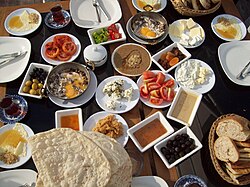
Goat cheese, goat's cheese, or chèvre is cheese made from goat's milk. Goats were among the first animals to be domesticated for producing food. Goat cheese is made around the world with a variety of recipes, giving many different styles of cheeses, from fresh and soft to aged and hard.

Kashkaval is a type of cheese made from cow's milk, sheep's milk or both. In Albania, Bulgaria, Kosovo, North Macedonia, Romania and Serbia, the term is often used to refer to all yellow cheeses. In English-language menus in Bulgaria, kashkaval is translated as "yellow cheese".

Allium ursinum, known as wild garlic, ramsons, cowleekes, cows's leek, cowleek, buckrams, broad-leaved garlic, wood garlic, bear leek, Eurasian wild garlic or bear's garlic, is a bulbous perennial flowering plant in the amaryllis family Amaryllidaceae. It is native to Europe and Asia, where it grows in moist woodland. It is a wild relative of onion and garlic, all belonging to the same genus, Allium. There are two recognized subspecies: A. ursinum subsp. ursinum and A. ursinum subsp. ucrainicum.

Mentha longifolia, also known as horse mint, brookmint, fillymint or St. John's horsemint, is a species of plant in the family Lamiaceae. It is native to Europe excluding Britain and Ireland, western and central Asia, and northern and southern Africa.
The Habitats Directive is a directive adopted by the European Community in 1992 as a response to the Berne Convention. The European Community was reformed as the European Union the following year, but the directive is still recognised.
NVC community CG2 is one of the calcicolous grassland communities in the British National Vegetation Classification system. It is one of three short-sward communities associated with heavy grazing, within the lowland calcicolous grassland group, and is regarded as "typical" chalk grassland.
The following outline is provided as an overview of and topical guide to herbs and spices:

The flora of Lebanon includes approximately 2,600 plant species. Situated on the eastern coast of the Mediterranean Basin, Lebanon is a reservoir of plant diversity and one of the world's biodiversity hotspots for conservation priorities. Endemic species constitute 12% of the Lebanese flora; 221 plant species are broad endemics and 90 are narrow endemics. Important Plant Areas (IPAs) featuring the country exceptional botanical richness were defined in 2018.
The precise taxonomy of the genus Allium is still poorly understood with incorrect descriptions being widespread. With over 850 species distributed over the Northern hemisphere Allium is the sole genus in the Allieae, one of four tribes of subfamily Allioideae (Amaryllidaceae). New species continue to be described and Allium is both highly variable and one of the largest monocotyledonous genera, but the precise taxonomy of Allium is poorly understood, with incorrect descriptions being widespread. The difficulties arise from the fact that the genus displays considerable polymorphism and has adapted to a wide variety of habitats. Furthermore, traditional classications had been based on homoplasious characteristics. However, the genus has been shown to be monophyletic, containing three major clades, although some proposed subgenera are not. Some progress is being made using molecular phylogenetic methods, and the internal transcribed spacer (ITS) region, including the 5.8S rDNA and the two spacers ITS1 and ITS2, is one of the more commonly used markers in the study of the differentiation of the Allium species.
The anthophytes are a grouping of plant taxa bearing flower-like reproductive structures. They were formerly thought to be a clade comprising plants bearing flower-like structures. The group contained the angiosperms - the extant flowering plants, such as roses and grasses - as well as the Gnetales and the extinct Bennettitales.

Ferula drudeana is a species of flowering plant in the family Apiaceae, native to the Central Taurus Mountains area of Turkey. It has been proposed as a candidate for the fabled silphium plant of antiquity. It is known from only three locations in Turkey, all sites of longstanding villages.






